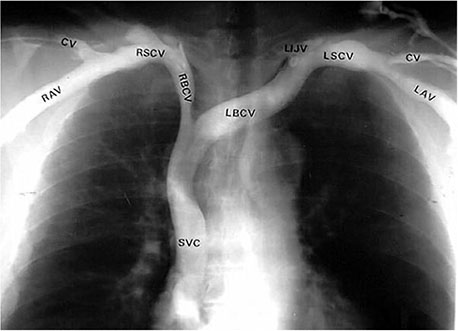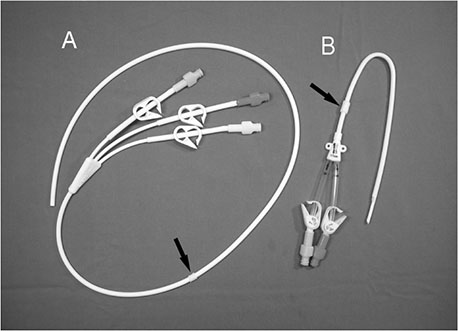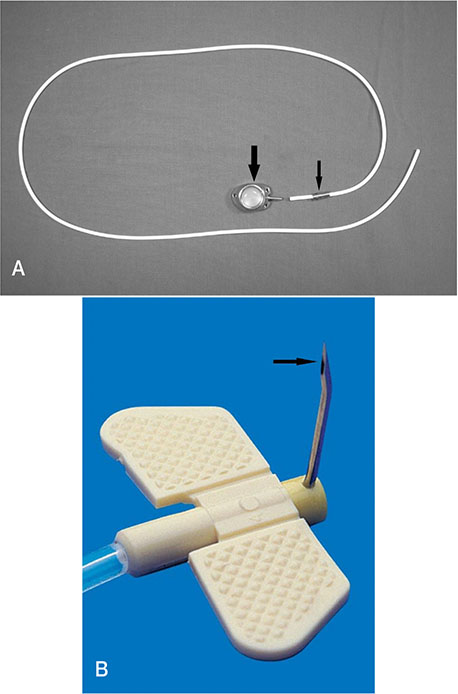Hanyang Med Rev.
2011 Feb;31(1):23-31. 10.7599/hmr.2011.31.1.23.
Insertion and Management of Central Venous Catheters
- Affiliations
-
- 1Department of Radiology, Ajou University School of Medicine, Suwon, Korea. jaeikbae@naver.com
- KMID: 2053748
- DOI: http://doi.org/10.7599/hmr.2011.31.1.23
Abstract
- The indications for placement of central venous catheters are continually expanding. The rapid growth of hemodialysis services, transplantation programs, and oncologic centers has contributed to the need for maintaining patients who require parenteral nutrition, hemodialysis, plasmapheresis, blood transfusion, blood sampling, and long-term chemotherapy for various neoplastic and infections disease. There are three basic categories of venous catheters: non-tunneled catheters, tunneled catheters and implantable ports. Each category of non-tunneled and tunneled catheter divided to infusion and high flow hemodialysis catheter. Peripherally inserted central catheter is a unique long non-tunneled catheter inserted through an arm vein. All physicians should have a deep understanding of each central venous catheters and ability to select the most appropriate one for each patient. Central venous catheterization should be performed by experts with imaging guidance. The high failure rate and high complication rate in the landmark bedside technique was revealed due to anatomical variance of veins. Appropriate management of the catheter is one of the most important parts should be understood by nurses as well as physician in central venous catheterization.
Keyword
MeSH Terms
Figure
Reference
-
1. Kadir S. Atlas of normal and variant angiographic anatomy. 1991. 1st ed. Philadelphia: Saunders;203–225.2. Mauro MA, Weeks SM. Baum S, Pentecost MJ, editors. Venous access. Abrams' angiography interventional radiology. 2006. 2nd ed. Philadelphia: Lippincott Williams & Wilkins;1142–1156.3. Ray CE Jr. Central venous access. 2001. 1st ed. Philadelphia: Lippincott Williams & Wilkins.4. Mauro MA, Black SE. Bakal CW, Silbrezweig JE, Cynamon J, Sprayregen S, editors. Central venous access. Vascular and interventional radiology: principal and practice. 2002. 1st ed. New York: Thieme Medical Publisher;441–458.5. Ganz PA. The quality of life after breast cancer-solving the problem of lymphedema. N Engl J Med. 1999. 340:383–385.
Article6. Kaufman JA, Crenshaw WB, Kuter I, Geller SC. Percutaneous placement of a central venous access device via an intercostal vein. AJR Am J Roentgenol. 1995. 164:459–460.
Article7. Denny DF Jr, Greenwood LH, Morse SS, Lee GK, Baquero J. Inferior vena cava: translumbar catheterization for central venous access. Radiology. 1989. 172:1013–1014.
Article8. Kaufman JA, Greenfield AJ, Fitzpatrick GF. Transhepatic cannulation of the inferior vena cava. J Vasc Interv Radiol. 1991. 2:331–334.
Article9. Schillinger F, Schillinger D, Montagnac R, Milcent T. Central venous stenosis in hemodialysis: comparative angiographic study of subclavian and internal jugular access. Nephrologie. 1994. 15:129–131.10. Vesely TM. Central venous catheter tip position: a continuing controversy. J Vasc Interv Radiol. 2003. 14:527–534.
Article11. Baskin KM, Jimenez RM, Cahill AM, Jawad AF, Towbin RB. Cavoatrial junction and central venous anatomy: implications for central venous access tip position. J Vasc Interv Radiol. 2008. 19:359–365.
Article12. Vesely TM. Air embolism during insertion of central venous catheters. J Vasc Interv Radiol. 2001. 12:1291–1295.
Article13. Penne K. Using evidence in central catheter care. Semin Oncol Nurs. 2002. 18:66–70.
Article14. Scheel PJ Jr, Kuhn D. Gray RJ, Sands JJ, editors. Management of the infected catheter. Dialysis access: a multidisciplinary approach. 2002. 1st ed. Philadelphia: Lippincott Williams & Wilkins;283–289.15. Krutchen AE, Bjarnason H, Stackhouse DJ, Nazarian GK, Magney JE, Hunter DW. The mechanisms of positional dysfunction of subclavian venous catheters. Radiology. 1996. 200:159–163.
Article16. Gray RJ, Levitin A, Buck D, Brown LC, Sparling YH, Jablonski KA, Fessahaye A, Gupta AK. Percutaneous fibrin sheath stripping versus transcatheter urokinase infusion for malfunctioning well-positioned tunneled central venous dialysis catheters: a prospective, randomized trial. J Vasc Interv Radiol. 2000. 11:1121–1129.
Article17. Ryder M. Evidence-based practice in the management of vascular access devices for home parenteral nutrition therapy. JPEN J Parenter Enteral Nutr. 2006. 30:S82–S93. S98–S99.
Article18. Goode CJ, Titler M, Rakel B, Ones DS, Kleiber C, Small S, Triolo PK. A meta-analysis of effects of heparin flush and saline flush: quality and cost implications. Nurs Res. 1991. 40:324–330.19. Karaaslan H, Peyronnet P, Benevent D, Lagarde C, Rince M, Leroux-Robert C. Risk of heparin lock-related bleeding when using indwelling venous catheter in haemodialysis. Nephrol Dial Transplant. 2001. 16:2072–2074.
Article20. Intravenous Nursing Society. Infusion Nursing Standards of Practice. J Intraven Nurs. 2000. 23:6 Suppl. S53–S54.21. Duszak R Jr, Haskal ZJ, Thomas-Hawkins C, Soulen MC, Baum RA, Shlansky-Goldberg RD, Cope C. Replacement of failing tunneled hemodialysis catheters through pre-existing subcutaneous tunnels: a comparison of catheter function and infection rates for de novo placements and over-the-wire exchanges. J Vasc Interv Radiol. 1998. 9:321–327.
Article
- Full Text Links
- Actions
-
Cited
- CITED
-
- Close
- Share
- Similar articles
-
- Accidental Insertion of Entire Catheter in the Right Femoral Vein during Central Venous Catheterization: A case report
- Inadvertent Arterial Catheterization of Central Venous Catheter: A Case Report
- Accidental Insertion of Entire Guide - Wire in the Inferior Vena Cava During Central Venous Catheterization
- Tension hydrothorax induced by malposition of central venous catheter: A case report
- Posterior triangle approach for lateral in-plane technique during hemodialysis catheter insertion via the internal jugular vein






